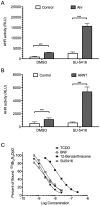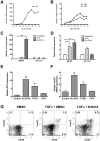SU5416, a VEGF receptor inhibitor and ligand of the AHR, represents a new alternative for immunomodulation
- PMID: 22970246
- PMCID: PMC3435281
- DOI: 10.1371/journal.pone.0044547
SU5416, a VEGF receptor inhibitor and ligand of the AHR, represents a new alternative for immunomodulation
Abstract
The experimental compound SU5416 went as far as Phase III clinical trials as an anticancer agent, putatively because of its activity as a VEGFR-2 inhibitor, but showed poor results. Here, we show that SU5416 is also an aryl hydrocarbon receptor (AHR) agonist with unique properties. Like TCDD, SU5416 favors induction of indoleamine 2,3 dioxygenase (IDO) in immunologically relevant populations such as dendritic cells in an AHR-dependent manner, leading to generation of regulatory T-cells in vitro. These characteristics lead us to suggest that SU5416 may be an ideal clinical agent for treatment of autoimmune diseases and prevention of transplant rejection, two areas where regulatory ligands of the AHR have shown promise. At the same time, AHR agonism might represent a poor characteristic for an anticancer drug, as regulatory T-cells can inhibit clearance of cancer cells, and activation of the AHR can lead to upregulation of xenobiotic metabolizing enzymes that might influence the half-lives of co-administered chemotherapeutic agents. Not only does SU5416 activate the human AHR with a potency approaching 2,3,7,8-tetrachlorodibenzo-p-dioxin, but it also activates polymorphic murine receptor isoforms (encoded by the Ahr(d) and Ahr(b1) alleles) with similar potency, a finding that has rarely been described and may have implications in identifying true endogenous ligands of this receptor.
Conflict of interest statement
Figures





Similar articles
-
Metabolism-based polycyclic aromatic acetylene inhibition of CYP1B1 in 10T1/2 cells potentiates aryl hydrocarbon receptor activity.Toxicol Appl Pharmacol. 1999 Dec 1;161(2):123-39. doi: 10.1006/taap.1999.8794. Toxicol Appl Pharmacol. 1999. PMID: 10581206
-
Malassezia-derived indoles activate the aryl hydrocarbon receptor and inhibit Toll-like receptor-induced maturation in monocyte-derived dendritic cells.Br J Dermatol. 2012 Sep;167(3):496-505. doi: 10.1111/j.1365-2133.2012.11014.x. Epub 2012 Jul 19. Br J Dermatol. 2012. PMID: 22533375
-
Induction of a chloracne phenotype in an epidermal equivalent model by 2,3,7,8-tetrachlorodibenzo-p-dioxin (TCDD) is dependent on aryl hydrocarbon receptor activation and is not reproduced by aryl hydrocarbon receptor knock down.J Dermatol Sci. 2014 Jan;73(1):10-22. doi: 10.1016/j.jdermsci.2013.09.001. Epub 2013 Sep 11. J Dermatol Sci. 2014. PMID: 24161567 Free PMC article.
-
Role of coactivators in transcriptional activation by the aryl hydrocarbon receptor.Arch Biochem Biophys. 2005 Jan 15;433(2):379-86. doi: 10.1016/j.abb.2004.09.031. Arch Biochem Biophys. 2005. PMID: 15581594 Review.
-
Immunoregulatory molecules are master regulators of inflammation during the immune response.FEBS Lett. 2012 Aug 31;586(18):2897-2905. doi: 10.1016/j.febslet.2012.07.032. Epub 2012 Jul 20. FEBS Lett. 2012. PMID: 22819828 Free PMC article. Review.
Cited by
-
Environmental alkylphenols modulate cytokine expression in plasmacytoid dendritic cells.PLoS One. 2013 Sep 11;8(9):e73534. doi: 10.1371/journal.pone.0073534. eCollection 2013. PLoS One. 2013. PMID: 24039973 Free PMC article.
-
Modeling the Effect of the Aryl Hydrocarbon Receptor on Transplant Immunity.Transplant Direct. 2017 Apr 25;3(5):e157. doi: 10.1097/TXD.0000000000000666. eCollection 2017 May. Transplant Direct. 2017. PMID: 28573192 Free PMC article.
-
Aryl Hydrocarbon Receptor Mechanisms Affecting Chronic Kidney Disease.Front Pharmacol. 2022 Feb 14;13:782199. doi: 10.3389/fphar.2022.782199. eCollection 2022. Front Pharmacol. 2022. PMID: 35237156 Free PMC article. Review.
-
Targeting Dietary and Microbial Tryptophan-Indole Metabolism as Therapeutic Approaches to Colon Cancer.Nutrients. 2021 Apr 3;13(4):1189. doi: 10.3390/nu13041189. Nutrients. 2021. PMID: 33916690 Free PMC article. Review.
-
STAT5a/b contribute to sex bias in vascular disease: A neuroendocrine perspective.JAKSTAT. 2015 Sep 18;4(3):1-20. doi: 10.1080/21623996.2015.1090658. eCollection 2015. JAKSTAT. 2015. PMID: 27141328 Free PMC article. Review.
References
-
- Amacher DE (2010) The effects of cytochrome P450 induction by xenobiotics on endobiotic metabolism in pre-clinical safety studies. Toxicol Mech Methods 20: 159–166. - PubMed
-
- Knerr S, Schrenk D (2006) Carcinogenicity of 2,3,7,8-tetrachlorodibenzo-p-dioxin in experimental models. Mol Nutr Food Res 50: 897–907. - PubMed
-
- Thackaberry EA, Gabaldon DM, Walker MK, Smith SM (2002) Aryl hydrocarbon receptor null mice develop cardiac hypertrophy and increased hypoxia-inducible factor-1alpha in the absence of cardiac hypoxia. Cardiovasc Toxicol 2: 263–274. - PubMed
Publication types
MeSH terms
Substances
Grants and funding
LinkOut - more resources
Full Text Sources
Other Literature Sources
Research Materials

